
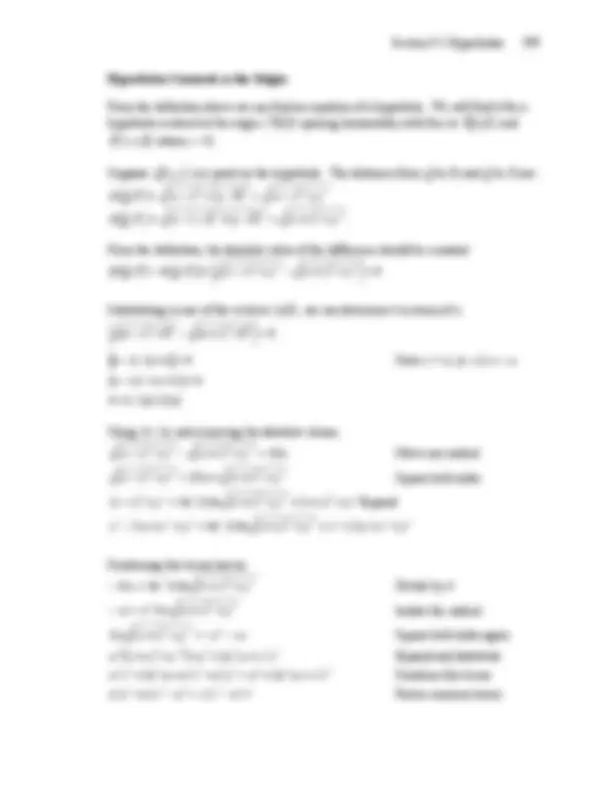
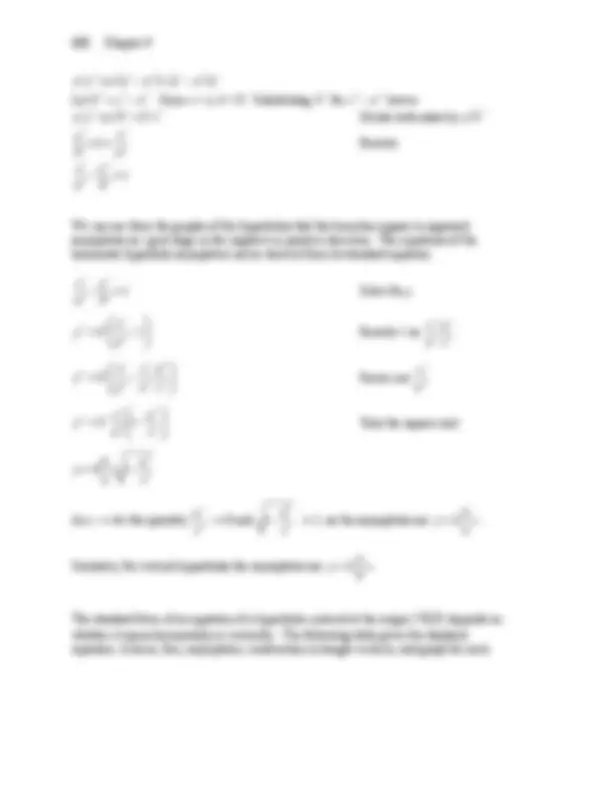

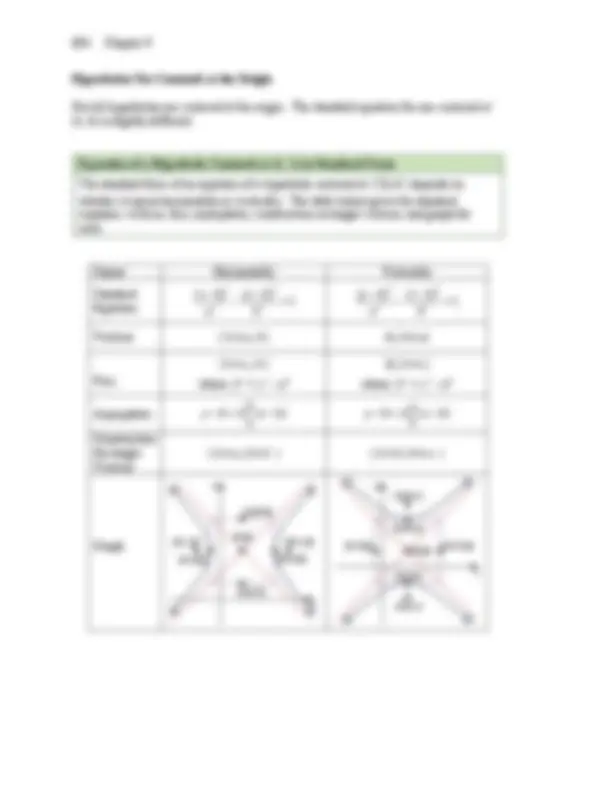
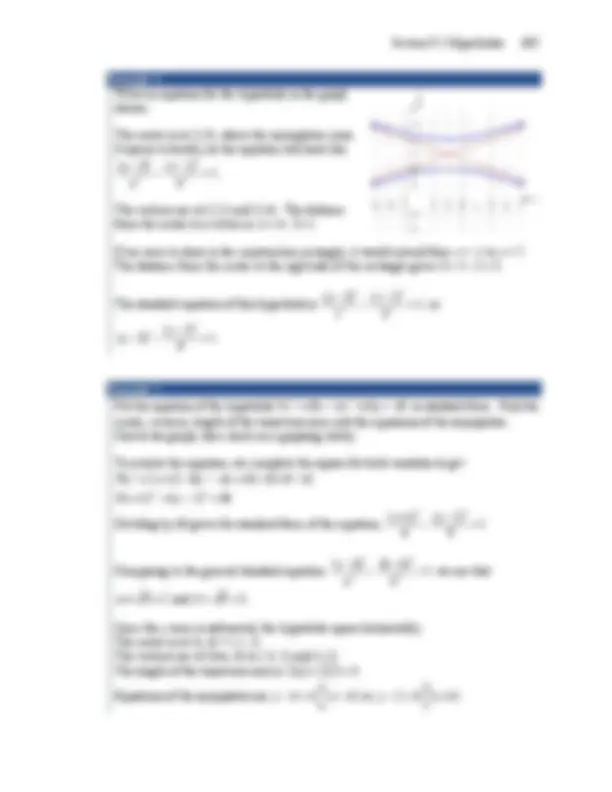
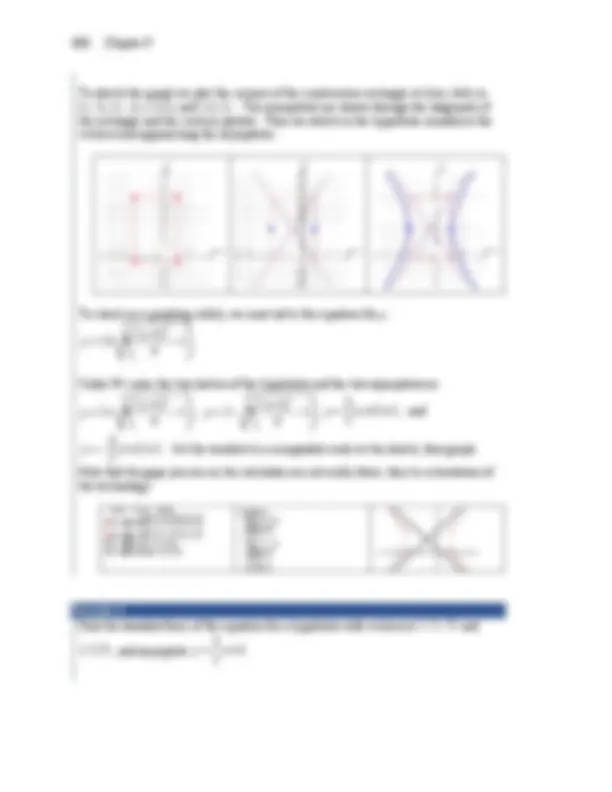
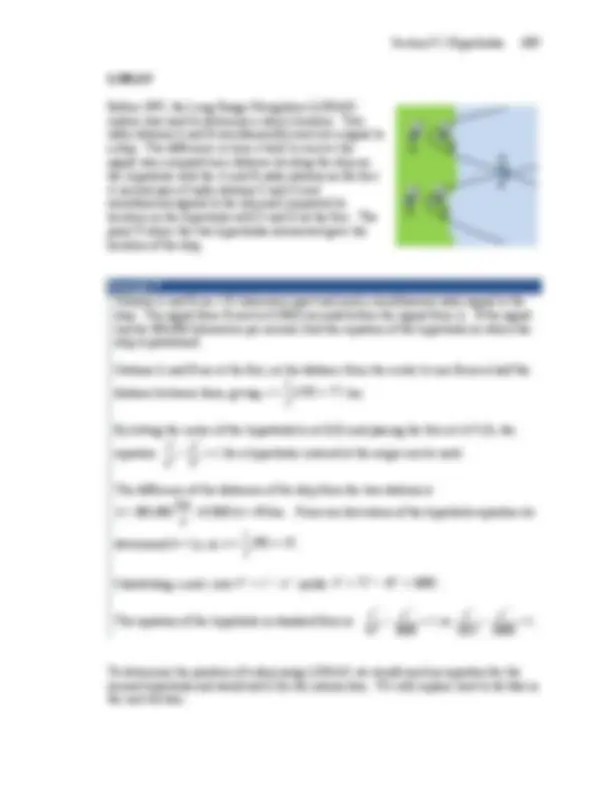
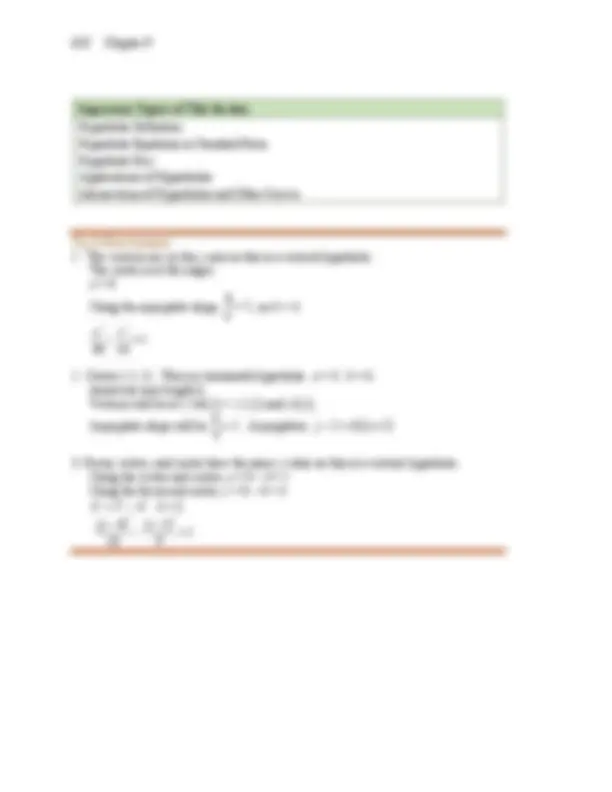
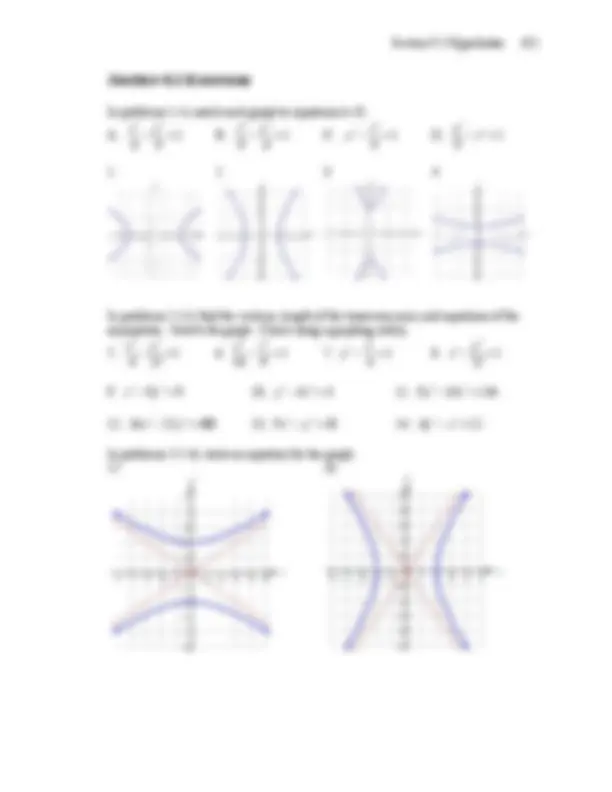
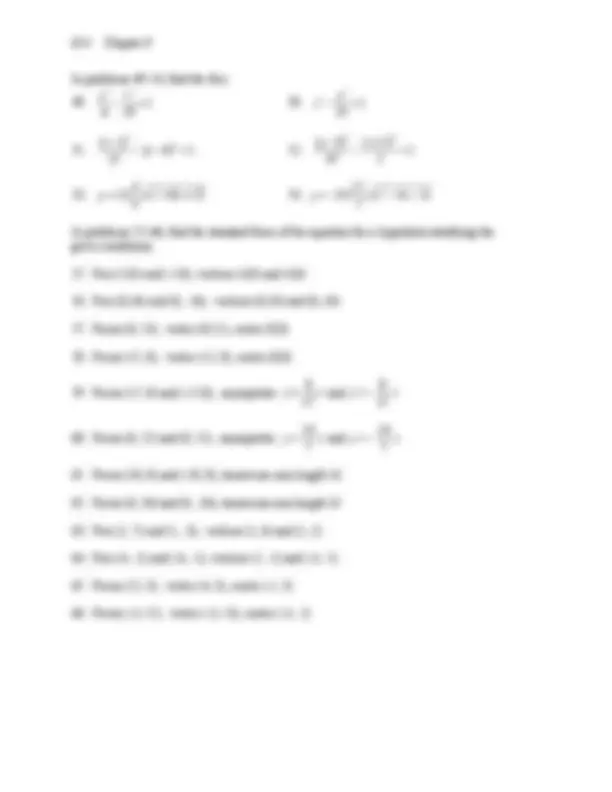
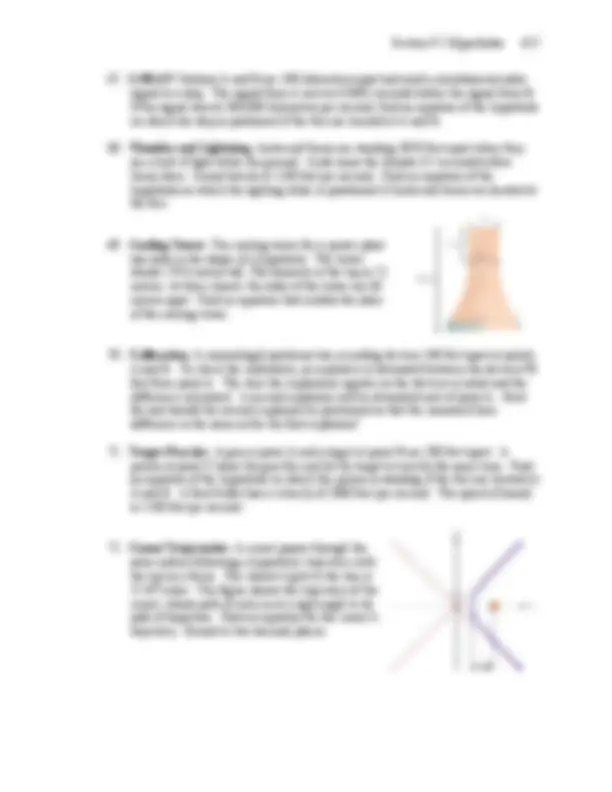
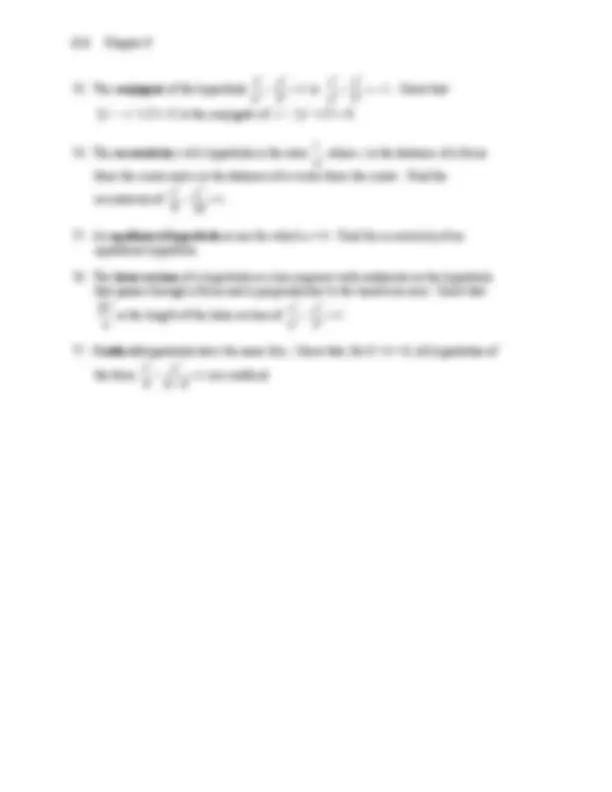


Study with the several resources on Docsity

Earn points by helping other students or get them with a premium plan


Prepare for your exams
Study with the several resources on Docsity

Earn points to download
Earn points by helping other students or get them with a premium plan
Community
Ask the community for help and clear up your study doubts
Discover the best universities in your country according to Docsity users
Free resources
Download our free guides on studying techniques, anxiety management strategies, and thesis advice from Docsity tutors
The definition, equations, and properties of hyperbolas, including the standard form, vertices, asymptotes, and foci. It also includes examples of finding the standard form of hyperbola equations given certain information and identifying the equations of asymptotes.
Typology: Exercises
1 / 20

This page cannot be seen from the preview
Don't miss anything!













Section 9.2 Hyperbolas 597
In the last section, we learned that planets have
approximately elliptical orbits around the sun. When an
object like a comet is moving quickly, it is able to escape
the gravitational pull of the sun and follows a path with the
shape of a hyperbola. Hyperbolas are curves that can help
us find the location of a ship, describe the shape of cooling towers, or calibrate
seismological equipment.
The hyperbola is another type of conic section created by intersecting a plane with a
double cone, as shown below^5.
The word “hyperbola” derives from a Greek word meaning “excess.” The English word
“hyperbole” means exaggeration. We can think of a hyperbola as an excessive or
exaggerated ellipse, one turned inside out.
We defined an ellipse as the set of all points where the sum of the distances from that
point to two fixed points is a constant. A hyperbola is the set of all points where the
absolute value of the difference of the distances from the point to two fixed points is a
constant.
(^5) Pbroks13 (https://commons.wikimedia.org/wiki/File:Conic_sections_with_plane.svg), “Conic sections
with plane”, cropped to show only a hyperbola by L Michaels, CC BY 3.
598 Chapter 9
Hyperbola Definition
A hyperbola is the set of all points Q (^ x , y )for which the absolute value of the
difference of the distances to two fixed points F 1 ( x 1 , y 1 )and F 2 ( x 2 , y 2 )called the foci
(plural for focus) is a constant k : d ( Q , F 1 ) − d ( Q , F 2 ) = k.
The transverse axis is the line passing through the foci.
Vertices are the points on the hyperbola which intersect the transverse axis.
The transverse axis length is the length of the line segment between the vertices.
The center is the midpoint between the vertices (or the midpoint between the foci).
The other axis of symmetry through the center is the conjugate axis.
The two disjoint pieces of the curve are called branches.
A hyperbola has two asymptotes.
Which axis is the transverse axis will depend on the orientation of the hyperbola. As a
helpful tool for graphing hyperbolas, it is common to draw a central rectangle as a
guide. This is a rectangle drawn around the center with sides parallel to the coordinate
axes that pass through each vertex and co-vertex. The asymptotes will follow the
diagonals of this rectangle.
x
y
d(Q,F 1 )
d(Q,F 2 )
F 1 F 2 x
y
d(Q,F 2 )
d(Q,F 1 )
Q
x
y
Vertex
Focus
Asymptote
Center
Co-vertex
Transverse axis
Conjugate axis
600 Chapter 9
2 2 2 2 2 2 2 2 a y + a c − a = c − a x
Let
2 2 2 b = c − a. Since c > a , b > 0. Substituting
2 b for
2 2 c − a leaves 2 2 2 2 2 2 a y + ab = bx Divide both sides by
2 2 ab
2
2
2
2 1 a
x
b
y
2
2
2 − = b
y
a
x
We can see from the graphs of the hyperbolas that the branches appear to approach
asymptotes as x gets large in the negative or positive direction. The equations of the
horizontal hyperbola asymptotes can be derived from its standard equation.
2
2
2 − = b
y
a
x Solve for y
2 2 2
a
x y b Rewrite 1 as 2
2
2
2
x
a
a
x
2
2
2
2
2 2 2
x
a
a
x
a
x y b Factor out 2
2
a
x
2
2
2 2 2 1 x
a
a
x y b Take the square root
2
2 1 x
a x a
b y = −
As x → ±∞ the quantity 2
2
x
a → 0 and 2
2 1 x
a − → 1, so the asymptotes are x a
b y =.
Similarly, for vertical hyperbolas the asymptotes are x b
a y =.
whether it opens horizontally or vertically. The following table gives the standard
equation, vertices, foci, asymptotes, construction rectangle vertices, and graph for each.
Section 9.2 Hyperbolas 601
Equation of a Hyperbola Centered at the Origin in Standard Form
Example 1
Put the equation of the hyperbola 4 4
2 2 y − x = in standard form. Find the vertices,
length of the transverse axis, and the equations of the asymptotes. Sketch the graph.
Check using a graphing utility.
The equation can be put in standard form 1 4 1
2 2 − =
y x by dividing by 4.
Comparing to the general standard equation 2 1
2
2
2 − = b
x
a
y
Opens (^) Horizontally Vertically
Standard
Equation
2
2
2 − = b
y
a
x 2 1
2
2
2 − = b
x
a
y
Vertices (- a , 0) and ( a , 0) (0, - a ) and (0, a )
Foci
(- c , 0) and ( c , 0)
where
2 2 2 b = c − a
(0, - c ) and (0, c )
Where
2 2 2 b = c − a
Asymptotes x a
b y = x b
a y =
Construction
Rectangle Vertices
( a , b ), (- a , b ), ( a ,- b ), ( - a , - b ) ( b , a ) , (- b , a ), ( b , - a ), ( - b , - a )
Graph
x
y
(0, b )
(- c ,0)
(0,- b )
(- a ,0) ( a ,0)^ ( c ,0) x
y
(0, a )
(0, c )
(- b ,0)
(0,- a )
(0,- c )
( b ,0)
Section 9.2 Hyperbolas 603
Example 2
Find the standard form of the equation for a hyperbola with vertices at (-6,0) and (6,0)
and asymptote y^ x 3
Since the vertices lie on the x - axis with a midpoint at the origin, the hyperbola is
horizontal with an equation of the form 2 1
2
2
2 − = b
y
a
x
. The value of a is the distance
from the center to a vertex. The distance from (6,0) to (0,0) is 6, so a = 6.
The asymptotes follow the form x a
b y =. From
y = x we see
b
a
= and
substituting a = 6 give us
b =. Solving yields b = 8.
The equation of the hyperbola in standard form is 1 6 8
2
2
2
2 − =
x y or 1 36 64
2 2 − =
x y .
Try it Now
and asymptote y = 2 x
Example 3
Find the standard form of the equation for a hyperbola with vertices at (0, 9) and (0,-9) and passing through the point (8,15).
Since the vertices lie on the y - axis with a midpoint at the origin, the hyperbola is
vertical with an equation of the form 2 1
2
2
2 − = b
x
a
y
. The value of a is the distance from
the center to a vertex. The distance from (0,9) to (0,0) is 9, so a = 9.
Substituting a = 9 and the point (8,15) gives 1
2
2
2
2 − = b
. Solving for b yields
2 2
−
b =.
The standard equation for the hyperbola is 1 9 6
2
2
2
2 − =
y x or 1 81 36
2 2 − =
y x .
604 Chapter 9
Hyperbolas Not Centered at the Origin
Not all hyperbolas are centered at the origin. The standard equation for one centered at
( h, k ) is slightly different.
Equation of a Hyperbola Centered at ( h, k ) in Standard Form
The standard form of an equation of a hyperbola centered at C ( h , k )depends on
whether it opens horizontally or vertically. The table below gives the standard equation, vertices, foci, asymptotes, construction rectangle vertices, and graph for
each.
Opens Horizontally Vertically
Standard
Equation
( ) ( ) 2 1
2
2
b
y k
a
x h ( ) ( ) 2 1
2
2
b
x h
a
y k
Vertices ( h ± a , k ) ( h , k ± a )
Foci
( h ± c , k )
where b^2 = c^2 – a^2
( h , k ± c )
where b^2 = c^2 – a^2
Asymptotes (^ x h ) a
b y − k = − ( x h ) b
a y − k = −
Construction
Rectangle
Vertices
( h ± a , k ± b ) ( h ± b , k ± a )
Graph
x
y
( h , k + b )
( h - c , k )
( h - a , k )^ ( h + a , k )
( h , k )
( h , k - b )
( h + c , k )
x
y
( h - b , k )
( h , k - a )
( h+b , k ) ( h , k )
( h , k - c )
( h , k + c )
( h , k + a )
606 Chapter 9
To sketch the graph we plot the corners of the construction rectangle at ( h ± a , k ± b ) or
(1, 5), (1, - 1), (-3,5), and (-3,-1). The asymptotes are drawn through the diagonals of
the rectangle and the vertices plotted. Then we sketch in the hyperbola rounded at the vertices and approaching the asymptotes.
To check on a graphing utility, we must solve the equation for y.
( )
2 x y.
Under Y= enter the two halves of the hyperbola and the two asymptotes as
( )
2 x y^ ,
( )
2 x (^) y , ( 1 ) 2 2
y = x + + , and
( 1 ) 2 2
y = − x + +. Set the window to a comparable scale to the sketch, then graph.
Note that the gaps you see on the calculator are not really there; they’re a limitation of
the technology.
Example 6
Find the standard form of the equation for a hyperbola with vertices at (^ −^2 ,−^5 )and
(− 2 , 7 ) , and asymptote 4 2
y =^ x +.
Section 9.2 Hyperbolas 607
Since the vertices differ in the y - coordinates, the hyperbola opens vertically with an
equation of the form
( ) ( ) 2 1
2
2
b
x h
a
y k and asymptote equations of the form
( x h ) b
a y − k = −.
The center will be halfway between the vertices, at ( 2 , 1 ) 2
The value of a is the distance from the center to a vertex. The distance from (− 2 , 1 )to
( − 2 ,− 5 ) is 6, so a = 6.
While our asymptote is not given in the form ( x h ) b
a y − k = − , notice this equation
would have slope b
a
. We can compare that to the slope of the given asymptote equation
to find b. Setting b
2
and substituting a = 6 gives us b = 4.
The equation of the hyperbola in standard form is
( ) ( ) 1 4
2
2
2
2
=
y − x or
( ) ( ) 1 16
y − x .
Try it Now
for the hyperbola
( ) ( ) 1 36
x + y .
Hyperbola Foci
The location of the foci can play a key role in hyperbola application problems. To find
them, we need to find the length from the center to the foci, c , using the equation 2 2 2 b = c − a. It looks similar to, but is not the same as, the Pythagorean Theorem.
Compare this with the equation to find length c for ellipses, which is
2 2 2 b^ = a − c. If you
remember that for the foci to be inside the ellipse they have to come before the vertices
( c a ) , it’s clear why we would calculate
2 a minus
2 c. To be inside a hyperbola, the
foci have to go beyond the vertices ( c a ), so we can see for hyperbolas we need
2 c
minus
2 ^ a , the opposite.
Section 9.2 Hyperbolas 609
Before GPS, the Long Range Navigation (LORAN)
system was used to determine a ship’s location. Two
radio stations A and B simultaneously sent out a signal to
a ship. The difference in time it took to receive the
signal was computed as a distance locating the ship on
the hyperbola with the A and B radio stations as the foci.
A second pair of radio stations C and D sent
simultaneous signals to the ship and computed its
location on the hyperbola with C and D as the foci. The
point P where the two hyperbolas intersected gave the
location of the ship.
Example 9
Stations A and B are 150 kilometers apart and send a simultaneous radio signal to the
ship. The signal from B arrives 0.0003 seconds before the signal from A. If the signal
travels 300,000 kilometers per second, find the equation of the hyperbola on which the ship is positioned.
Stations A and B are at the foci, so the distance from the center to one focus is half the
distance between them, giving (^150 )^75 2
c = = km.
By letting the center of the hyperbola be at (0,0) and placing the foci at (±75,0), the
equation 2 1
2
2
2 − = b
y
a
x for a hyperbola centered at the origin can be used.
The difference of the distances of the ship from the two stations is
( 0. 0003 s) 90 km s
km k = 300 , 000 =. From our derivation of the hyperbola equation we
determined k = 2 a , so (^90 )^45 2
a = =.
Substituting a and c into
2 2 2 b^ = c − a yields^75
2 2 2 b = − =.
The equation of the hyperbola in standard form is 1 45 3600
2
2
2 − =
x y or 1 2025 3600
2 2 − =
x y .
To determine the position of a ship using LORAN, we would need an equation for the
second hyperbola and would solve for the intersection. We will explore how to do that in
the next section.
610 Chapter 9
Important Topics of This Section
Hyperbola Definition
Hyperbola Equations in Standard Form
Hyperbola Foci
Applications of Hyperbolas
Intersections of Hyperbolas and Other Curves
Try it Now Answers
The center is at the origin.
a = 8
Using the asymptote slope,^2
b
, so b = 4.
2 2 − =
y x
transverse axis length 6,
Vertices will be at (- 5 ±3,2) = (-2,2) and (-8,2),
Asymptote slope will be 2 3
=. Asymptotes: y − 2 = 2 ( x + 5 )
Using the vertex and center, a = 9 – 4 = 5
Using the focus and center, c = 8 – 4 = 4 2 2 2 b = 5 − 4. b = 3.
( ) ( ) 1 9
2 2
=
y − x
612 Chapter 9
In problems 17–22, find the standard form of the equation for a hyperbola satisfying the
given conditions.
In problems 2 3 – 30, match each graph to equations A–H.
( ) ( ) 1 4
x − y E.
( ) ( ) 1 9
y − x
( ) ( ) 1 4
2 2
=
x + y F.
( ) ( ) 1 9
2 2
=
y + x
( ) ( ) 1 16
x + y G.
( ) ( ) 1 16
y + x
( ) ( ) 1 16
2 2
=
x − y H.
( ) ( ) 1 16
2 2
=
y − x
Section 9.2 Hyperbolas 613
In problems 31–40, find the center, vertices, length of the transverse axis, and equations
of the asymptotes. Sketch the graph. Check using a graphing utility.
( ) ( ) 1 4
x − y
( ) ( ) 1 36
y − x
( ) ( 2 ) 1 9
2 − + =
x
y
( ) ( 6 ) 1 25
2 − − =
y
x
2 2 x − x − y = 36. 4 16 9 20
2 2 y + y − x =
2 2 y − y − x − x = 38. 4 16 6 29
2 2 x − x − y + y =
2 2 x + x − y + y = 40. 9 36 16 96 36
2 2 y + y − x − x =−
In problems 41–42, write an equation for the graph.
In problems 43–44, find the standard form of the equation for a hyperbola satisfying the
given conditions.
y + 3 = x −
In problems 45–48, find the center, vertices, length of the transverse axis, and equations
of the asymptotes. Sketch the graph. Check using a graphing utility.
2 y = x − 46. 9 1 4
y = x +
2 y =^ x + x + 48.^1
2 = − x − x +
Section 9.2 Hyperbolas 615
signal to a ship. The signal from A arrives 0.0002 seconds before the signal from B.
If the signal travels 300,000 kilometers per second, find an equation of the hyperbola
on which the ship is positioned if the foci are located at A and B.
see a bolt of light strike the ground. Anita hears the thunder 0.5 seconds before
Samir does. Sound travels at 1100 feet per second. Find an equation of the
hyperbola on which the lighting strike is positioned if Anita and Samir are located at the foci.
has sides in the shape of a hyperbola. The tower stands 179.6 meters tall. The diameter at the top is 72
meters. At their closest, the sides of the tower are 60
meters apart. Find an equation that models the sides
of the cooling tower.
A and B. To check the calibration, an explosive is detonated between the devices 90
feet from point A. The time the explosions register on the devices is noted and the
difference calculated. A second explosion will be detonated east of point A. How far east should the second explosion be positioned so that the measured time
difference is the same as for the first explosion?
person at point C hears the gun fire and hit the target at exactly the same time. Find an equation of the hyperbola on which the person is standing if the foci are located at
A and B. A fired bullet has a velocity of 2000 feet per second. The speed of sound
is 1100 feet per second.
solar system following a hyperbolic trajectory with
the sun as a focus. The closest it gets to the sun is
3×
8 miles. The figure shows the trajectory of the
comet, whose path of entry is at a right angle to its path of departure. Find an equation for the comet’s
trajectory. Round to two decimal places.
3×10^8
616 Chapter 9
2
2
2 − = b
y
a
x is 2 1
2
2
2 − = − b
y
a
x
. Show that
2 2 y − x + = is the conjugate of 5 25 0
2 2 x − y + =.
c , where c is the distance of a focus
from the center and a is the distance of a vertex from the center. Find the
eccentricity of 1 9 16
2 2 − =
x y .
equilateral hyperbola.
that passes through a focus and is perpendicular to the transverse axis. Show that
a
b
2 2 is the length of the latus rectum of 2 1
2
2
2 − = b
y
a
x .
the form 1 6
−
k
y
k
x are confocal.